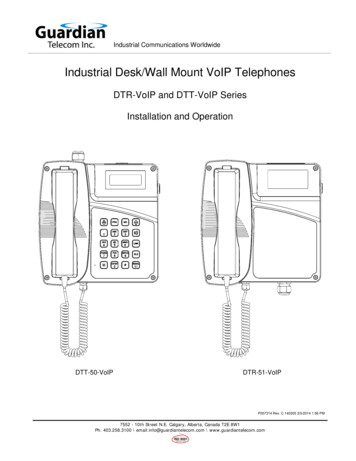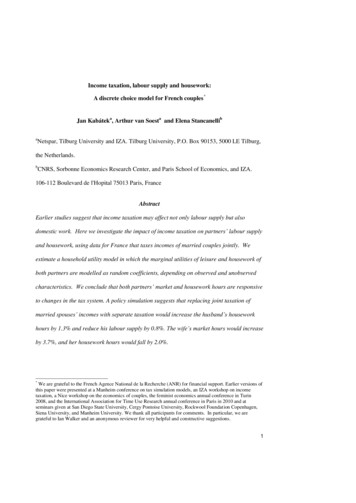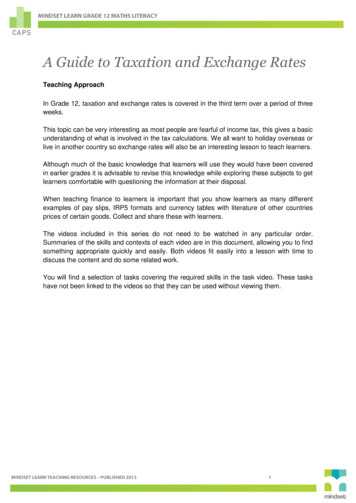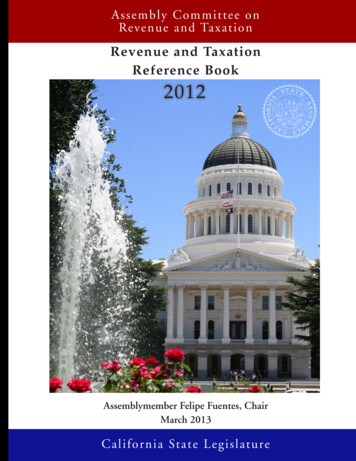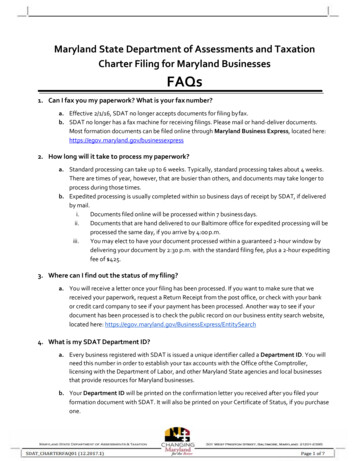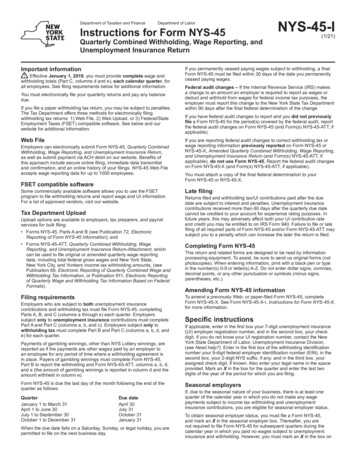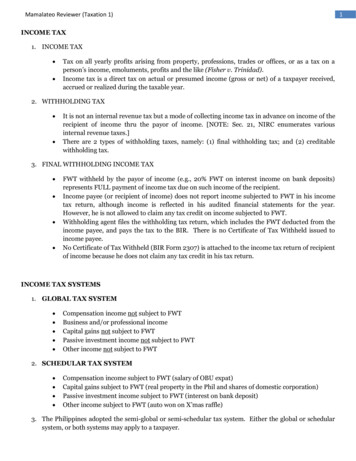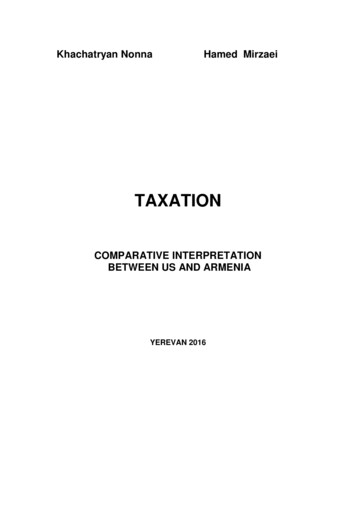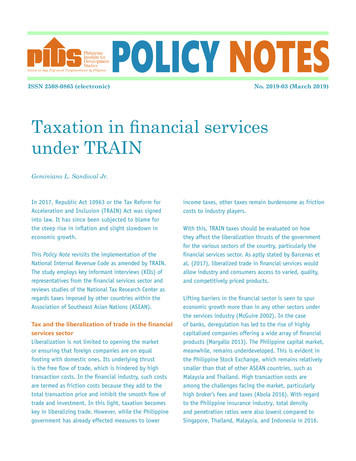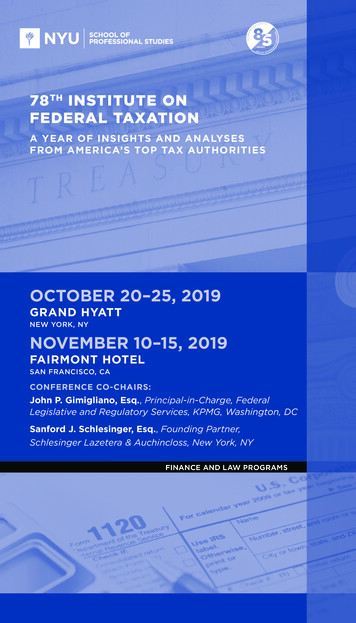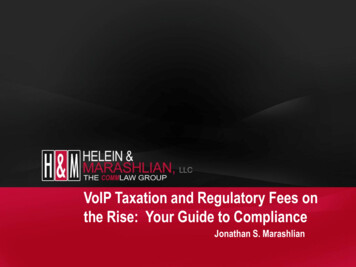
Transcription
VoIP Taxation and Regulatory Fees onthe Rise: Your Guide to ComplianceJonathan S. Marashlian
Speaker Info: Jonathan MarashlianJonathan S. Marashlian is the Managing Partner of The CommLaw Group and chairs the firm’s Regulatory and CommunicationsTaxes and Fees Practices. Mr. Marashlian is also the founder and CEO of the firm’s regulatory compliance consulting firm, TheCommpliance Group. Mr. Marashlian boasts a vibrant and diverse telecom law practice serving clients in every sector of theindustry, including: Cloud Communications and other Communications as a Software ("CaaS") providers Traditional wireline telecommunications services, such as domestic & international Long Distance and Competitive LocalExchange Information & enhanced communications services Wireless services Broadband & Internet Access services Advanced communication application (apps) services & developers All forms of Internet Based (IP-based) services, including Voice over Internet (“VoIP”) and other hybrid & convergentcommunications service providers Communications equipment manufacturersMr. Marashlian specializes in communications taxes, Universal Service Fund (USF), E-911 and regulatory fee issues and alsomaintains an active administrative Litigation and Dispute Resolution practice representing service providers in FCC, PUC andAttorney General enforcement actions. Other specializations include: FCC and State (PUC/Secy of State) regulatory, transactional,tax, litigation and advocacy; communications taxes & VoIP taxation issues; regulatory fees & tax planning; wireline & wirelesstransfers/assignments of control; licensing & tariffing; customer base/asset sales; regulatory reporting & compliance, contractdrafting & negotiation; dispute resolution; FCC advocacy and representation in administrative proceedings, including rulemakings,declaratory petitions, and enforcement proceedings.About the FirmThe CommLaw Group is unique among its peers, offering clients a scope of capabilities rarely found in boutique law firms. With aheadcount rivaling the Telecom Practice Groups of most major law firms, we boast a team of attorneys, paraprofessionals andconsultants possessing the skills, focus and resources necessary to serve the communications law needs of Fortune 100companies, all without sacrificing the range of services and affordability which makes us the "go to" firm for new entrants andservice providers of all sizes.www.CommLawGroup.com
Introduction & Overview Who are we? What topics will we cover today? Brief History of VoIP Regulation Examples of VoIP Services Fees & Taxes Part I: Regulatory FeesPart II: 911/E-911Part III: TaxesPart IV: Supply Chain Enforcement Why is this important? What’s next?
Stevens Report to Vonage Preemption toToday: The (r)evolution of VoIP (regulation,that is) 1998 - Stevens Report to Congress– ACTA Petition & VON Coalition 2004 - Vonage Preemption Order– Interconnected VoIP services subject to exclusive jurisdiction of FCC?– IP-Enabled Rulemaking– Internet ―tax free‖ zone? 2006 - AT&T IP-in-the-Middle– FCC Defines ―VoIP Toll‖– Extension to Wholesale 2007 - Compass Global Notice of Apparent Liability Today
And then there was “InterconnectedVoIP” June 2005 - FCC ―creates‖ new communications service ―I-VoIP‖ defined as service possessing ALL of the followingcharacteristics:(1) enables real-time, two-way voice communications;(2) requires a broadband connection from the user’s location;(3) requires IP-compatible customer premises equipment; and(4) permits users to receive calls from and terminate calls to the PSTN. ―Off net‖ communications Substantial substitute
Vonage: The Prototypical I-VoIP Service Vonage is an ―off-net‖ IP-based telephony systemo Functionally equivalent . from the consumer’s perspectiveo Technical differences:1)2)3)4) Must have access to broadband connection to the Internet;Specialized CPE;Integrated capabilities and features; andNANP numbers used with the service are not tied to the user’s physicallocation―Substantial replacement‖
What is NOT I-VoIP? Purely ―on-net‖ or ―computer-to-computer‖ serviceso Example: Pulver.com’s Free World Dial-Up Closed network, purely ―on net‖ services are classified by FCC as―information services‖ ―Definitionaly exempt‖o Example: Skype in and/or Skype out service Skype fails to incorporate the fourth prong Does not permit users to both receive calls from and terminate calls to thePSTN Curious case of MagicJack ?
“IP-in-the-Middle”The Regulation of Wholesale ―IP-In-The-Middle‖ or ―VoIP Toll‖– Separate category of IP-enabled service, characterized by:1. use of ordinary customer premises equipment with no enhancedfunctionality;2. origination and termination on the PSTN; and3. which undergoes no net protocol conversion and provides no enhancedfunctionality to end user stemming from the use of IP technology.– VoIP Toll is a ―telecommunications service‖– Compass Global NAL ―IP-in-the Middle‖ minefield of complex regulatory & taxconsequences for companies who:– Transport , switch or route voice bearing IP packets
Retail I-VoIPIt’s more than just VonageCommon Indicia of a Retail VoIP Telephony Service: Uses computers with multimedia hardware rather than hard-wired circuits and POTs lines to enableusers to place calls;VoIP telephones and multimedia PCs convert analog voice signals into digital data streams;Telephone signals are routed over IP networks instead of over circuit-switched networks;A call path usually consists of contacting a target PC on the Internet or to connect to a standardtelephone set via a gateway between the Internet and the PSTN;Original VoIP signaling standard: ISH H.323; today, most networks use Session Initiation Protocol (SIP)as a signaling standard;IP Telephones are intelligent terminals:o Hard phones (hardware-based) oro Soft phones (software-based, residing on desktops, laptops, tablets, handhelds or other computerplatforms);All IP phones, whether Hard Phone or Soft Phone are basically computer terminals with an Ethernet LANaddress associated with a Network Interface Card (NIC) and an IP address. Plug into an Ethernet port,initialize with a password and ID, and the phone is active.
Retail I-VoIPIt’s more than just Vonage I-VoIP Comes in a Variety of Flavors: IP-Enabled PBX IP PBX Hybrid TDM/IP PBX IP Call Centers (―Click to Talk to an Agent‖)
Fixed vs. Nomadic The difference between ―fixed VoIP‖ and ―nomadic‖ VoIP‖ “Fixed VoIP” – Only permits a subscriber to make calls from a fixed address. FixedVoIP is ordinarily provided over a private communications network rather than theInternet. Because the origination or termination point of a fixed VoIP call can be readilyidentified, many of the regulatory and taxation pitfalls discussed in this presentation areminimized (or outright inapplicable to) fixed VoIP service. “Nomadic VoIP” – Enables a subscriber to access the Internet to make a call from anybroadband internet connection. Because a call may originate from, or terminate to, anylocation, the FCC has held that it would be impractical, if not impossible, to separate theintrastate portion of VoIP service from the interstate portion and state regulation wouldconflict with federal rules and policies.
Tax or FeeWhat’s the difference? Does it matter? Regulatory feeso Owed by Service Providero Pass-through is permissiveo Examples: Universal Service Fund Telecom Relay Service Fund Taxeso Owed by consumero Service Provider is ―tax collector‖ 911/E-911 Fees?
Facts about Taxes & FeesDistinctions to Keep in Mind No federal taxes on VoIPo USF is not a tax! State regulatory feeso USF/Relay Services/Othero 911/E-911 State taxeso Sales, Use and Excise taxes on communications serviceso Service provider collects and remits taxes owed by retail consumer
Big Picture Question:Is VoIP Regulated? Federal Communications Commission– YES State Utility Commissions– YES TO SOME– NO TO OTHERS Local Governments– YES, 911 ONLY
Big Picture Question:Is VoIP Taxed? Departments of Revenue, Comptrollers, other state taxingauthorities– MOST, BUT NOT ALL State and/or local E-911 Fund Administrators– YES Select Local Governments– YES
But what about the Internet Tax FreedomAct? Internet as a ―tax-free‖ zone, not so Internet Tax Freedom Acto Places a moratorium on taxation of Internet access at the state and local levelo Protects e-commerce from sales tax for out-of-state transactions Moratorium extended until 2014 ITFA does not prevent FCC from using ―ancillary‖ Title I jurisdiction to assessregulatory contributions States not reluctant to assess certain regulatory fees and communications-relatedtransaction taxes on I-VoIP– Nexus; and– Definition of ―telecommunications‖ or ―telephone service‖ in the state’s taxstatute
PART I: Regulatory FeesSource Financial Times, Gapper Bloghttp://blogs.ft.com/gapperblog/2008/0317
Compliance Concerns on the Federal Level:Annual FCC Form 499-A: “TelecommunicationsReporting Worksheet – Annual Filing” Form 499-A due annually on or before April 1st Revenue reported in Form 499 used to calculate contributions to:––––Federal Universal Service FundFederal Telecommunications Relay Services FundNorth American Numbering PlanShared costs of Local Number Portability Revenue data from Form 499-A also forms the basis fortelecommunications annual federal regulatory fees
Compliance Concerns on the Federal Level:Annual FCC Form 499-A: “TelecommunicationsReporting Worksheet – Annual Filing” I-VoIP providers NOT telecommunications carriers However, through ―ancillary‖ Title I authority and public interest clause ofSection 254(d) , FCC requires I-VoIP providers to contribute to USF,TRS, NANP, LNP and pay annual FCC fees(d) Telecommunications Carrier Contribution: Every telecommunications carrierthat provides interstate telecommunications services shall contribute, on anequitable and nondiscriminatory basis, to the specific, predictable, and sufficientmechanisms established by the Commission to preserve and advance universalservice. The Commission may exempt a carrier or class of carriers from thisrequirement if the carrier's telecommunications activities are limited to such anextent that the level of such carrier's contribution to the preservation andadvancement of universal service would be de minimis. Any other provider ofinterstate telecommunications may be required to contribute to thepreservation and advancement of universal service if the public interest sorequires.
State Regulatory Encroachment Despite FCC preemption of state-specific market entry requirements and rateregulations of nomadic VoIP service, states continue to aggressively seek in-roadswhich would permit them to circumvent FCC pre-emption orders and collect StateUSF Fund assessments on I-VoIP revenues.– Nebraska and Kansas Joint FCC Petition
Existing State Regulatory Requirements State Commissions not pre-empted from applying generally-applicable E-911,Public Safety, CPNI and consumer protection statutes to I-VoIP providers States not pre-empted from enacting CPNI rules which are not inconsistent withFederal CPNI Rules Likewise, there is a great deal of similarity in state public safety, consumerprotection and unfair trade practices statutes; however, certain differences do exist.For example:o NY consumer protection rules require I-VoIP providers to notify consumers before servicecommencement, of any material limitations associated with basic or enhanced 911 services, andwhether such service is basic 911 or enhanced 911 service.o NY also requires I-VoIP providers to secure a customer’s express acknowledgement that customeris aware of 911 limitations prior to service commencement.
Existing State Regulatory Requirements State entry requirements (Certificate of Public Convenience and Necessity) are preempted with respect to nomadic VoIP service, not so for ―fixed‖ or ―facilities-based‖VoIP. Other states require a ―registration-like‖ filing from all VoIP providers (forinformational purposes):o Montanao Nebraskao Indianao As of June 30, 2009, the Indiana Utilities Regulatory Commission required all communicationsservice providers, including providers of Internet protocol enabled service, to file anApplication for a Communications Service Provider Certificate of Territorial Authority. Whilemore substantial than a mere ―registration‖ or notice filing, Indiana routinely grants CTAs onan automatic basis after 30 days. No party has challenged the requirement as in violation ofthe FCC’s pre-emption decision in the Vonage Minnesota Order.
Regulation Free Zones? A number of States claim that they do not regulate VoIP at giaIndianaKentuckyMarylandNew JerseyOhioPennsylvania Yet many of these same states do impose regulatory fees o E911 assessmentso State TRS feeso Public safety, consumer protection and fair trade practices, etc.
Examples of State Regulatory Status of VoIPALABAMANo jurisdiction over VoIP but E911 charges doapplyARKANSASE911 and USF chargesCOLORADOVoIP is “unregulated” but E911 charges andCPNI rules applyGEORGIANo USF, TRS or Reg Fees but CPNI rules doapplyLOUISIANAE911 does not apply to VoIP but USF doesMISSOURIRegistration and Annual Report required amongother obligationsMONTANAE911 and TDD service fees applySOUTH CAROLINAE911 charge and CPNI rules applyWISCONSINCPNI rules apply
PART II: 911/E-911
States with 911 SurchargesApplicable to VoIP
Examples of State 911 SurchargesApplied to Interconnected VoIPALABAMAARIZONA 0.70 statewide on each 10-digit access numberassigned to a customer 0.20 per month, per activated lineARKANSAS 0.50 per month per connectionFLORIDANEW JERSEY 0.50 per month per each “service identifier” (I-VoIPsubscriber) 1.00 per month per “access line” (any technologythat is able to provide dial tone) 1.00 per month (applies to “other 9-1-1 accessibleservices”) 0.59 per month per VoIP telephone subscriberNORTH CAROLINA 0.70 per month per service connectionOKLAHOMA 0.50 per month per VoIP userSOUTH DAKOTAMaximum 0.75 per month per service user lineTEXASWireline fee includes I-VoIPWEST VIRGINIAFees vary by County.IDAHOMONTANA
PART III: TaxesSource Jack Kingston Blog,http://kingston.house.gov/
Tax Compliance Concernson the State Level Factors to consider to determine taxability:o ―Nexus‖ between the retail I-VoIP provider and the stateo Precise definition of ―telecommunications‖ or ―telephone service‖ in the state’stax statutes or regulationso Bundling of taxable services with non-taxable services Most states apply taxes on VoIP in reliance on extensions of preexisting statutory/regulatory languageo A few are explicit: Illinois and New Jersey (general tax statutes specifically encompass VoIP); Louisiana and New York (specific portions of tax statutes specificallyencompass VoIP
Communications Tax Implications General Business Taxes – Always applicable to VoIP providers (e.g.,State Corporate Income Taxes, State Property Taxes) Communications Taxes – Since 2006, increasingly being applied andenforced What’s the difference? General business operating nationwide appx. 7,000 tax returns According to the same study, a telecommunications services provider isresponsible for filing over 47,000 different tax returns annually
Examples of State TaxesApplied to VoIP ALABAMAUtilities Gross Receipts Tax & Utilities Service Use TaxARKANSASSales Tax FLORIDAStatewide communications tax (and certain localities impose telecom taxes of their own)LOUISIANASales and Use TaxMISSOURIState (but not local) Sales TaxNORTH CAROLINASales and Use TaxPENNSYLVANIASales TaxSOUTH CAROLINASales TaxSOUTH DAKOTAUse Tax & Retail Sales TaxWISCONSINSales Tax
States Imposing TelecommunicationsTax Obligations on VoIP
State Taxation Issues –Definition of Telecommunications State and local definitions of taxable telecommunications are broadand inconsistent– Often inconsistent with FCC definitions– Even inconsistent with definitions used by State’s Utility Commission State and local tax definitions of telecommunications often includetransmission of voice and data regardless of medium, method orprotocol. Examples:o ―Or other medium or method now in existence or hereafter devised, regardless of theprotocol used for such transmission or conveyance.‖ ―. . . and Internet telephony.‖o ―The transport over the Internet or any proprietary network using the Internet protocol oftelephone calls ‖ Retroactive application– Example: New York excise tax on telecommunications
State Taxation Issues –“Nexus” Requirements Due Process and Commerce Clause provisions of the U.S. Constitutionrequire that there be a minimal contact or presence in the taxing jurisdictionby the business.– There are many activities — too many to list here — which can create the jurisdictionalright to tax, referred to as "nexus―. Different states have developed different interpretations of what types ofbusiness activities constitute sufficient ―nexus‖ to impose their taxobligations on out-of-state businesses. The states’ determination of sufficient ―nexus‖ is an extremely fact-drivenanalysis, and even within the same state seemingly similar businessactivities can result in dramatically different tax obligations.
State Taxation Issues –Bundled Services ―Off net‖ VoIP Services typically bundled with noncommunicationsWhat part of the bundle is subject to state communicationstax? Various standards used by states include: No uniform, national policy―true object‖ testsde minimis tests―primary object‖ tests and―essence of the transaction‖ testsThe same bundled service offering can result in vastlydifferent tax obligations depending on the taxing jurisdiction.
Tax Compliance Concerns at theLocal LevelA troubling “local taxation” precedent:Mayor and City Council of Baltimore v. Vonage (2008): A recent notable court case upheld a 3.50 monthly city telecommunications tax assessed upon a nomadic VoIP provider.–City Tax applicable to each person who provided a telecommunications line to anycustomer of wired service whose billing address was in the City of Baltimore.–Vonage argued it did not provide or furnish telecommunications lines and thus the tax didnot apply–Court disagreed, holding that Vonage was selling a service that included the use of a―telecommunications line‖ and was therefore within ordinance
Tax Compliance Concerns on theLocal Level Baltimore v. Vonage fallout Even though California does not apply its state level salesand use tax to telecommunications, in wake of Baltimorev. Vonage:––San Francisco began imposing 7.5% tax on telecommunicationsCity of Los Angeles began imposing 9% use tax on communications. Challenging present, but even more ominous future forretail VoIP providers
PART IV: Supply Chain EnforcementSource nagement.html
FCC Supply Chain Enforcement:“Carrier’s Carrier Rule”FEDERAL UNIVERSAL SERVICE FUND –CARRIER’S CARRIER RULE Revenue from resellers is wholesale, thereby excluded from wholesaler’s USFcontribution base Carrier’s Carrier Rule requires verification and validation Stated purpose is to prevent duplicative contributions In reality, used by USAC and FCC as a supply chain enforcement mechanism Threat of vicarious liability– Tier 1 Carriers with large wholesale revenue base fear re-classification of revenue enforces on Tier2s– Tier 2 Carriers faced with option to eat 10-15% in pass-throughs, enforce on Tier 3s– Tier 3s increasingly compliant with FCC Regulations thanks to supply chain enforcement!
FCC Supply Chain Enforcement:“Carrier’s Carrier Rule” In traditional ―circuit-switched‖ telecom supply chain,identifying who is responsible for payment of FederalUSF – and which entity to pursue if payment is notultimately remitted – is relatively straightforwardUnderlying carri
Vonage: The Prototypical I-VoIP Service Vonage is an ―off-net‖ IP-based telephony system o Functionally equivalent . from the consumer’s perspective o Technical differences: 1) Must have access to broadband connection to the Internet; 2) Spec
